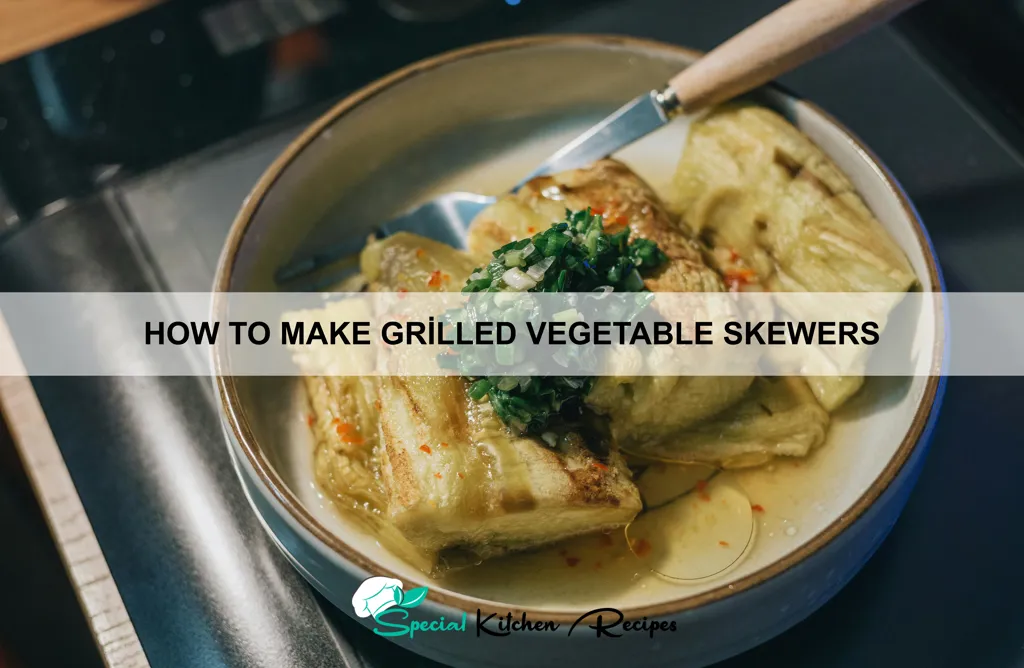Grilled vegetable skewers, a vibrant and healthy culinary delight, boast a history as rich and varied as the vegetables themselves. While pinpointing a precise origin is difficult, the concept of grilling vegetables on skewers dates back centuries, likely emerging independently in various cultures around the globe. Ancient civilizations, from the Greeks and Romans to those in the Middle East and Asia, utilized similar methods for cooking food over open flames, often incorporating vegetables alongside meats and other ingredients. The specific use of skewers likely facilitated easier cooking and portioning, especially in large-scale preparations or communal feasts.
The popularity of vegetable skewers has seen a significant surge in recent years, driven by increasing awareness of healthy eating and the rise of global cuisine. According to a 2023 survey by the National Restaurant Association, vegetarian and vegan options are increasingly in demand, with grilled vegetable skewers consistently ranking among the top choices. This reflects a broader societal shift towards plant-based diets and a growing appreciation for fresh, seasonal ingredients. Furthermore, the versatility of vegetable skewers contributes to their appeal. They can be customized to suit individual preferences and dietary needs, readily incorporating seasonal produce and diverse flavor profiles.
Culturally, grilled vegetable skewers hold diverse meanings and significance. In Mediterranean cultures, they represent the simplicity and freshness of seasonal produce, often featuring ingredients like zucchini, bell peppers, and onions, seasoned with herbs like oregano and thyme. In Asian cuisines, variations abound, incorporating ingredients like mushrooms, eggplant, and tofu, reflecting regional preferences and cooking traditions. The act of sharing these skewers, whether at a family gathering or a social event, often signifies community and togetherness. The ease of preparation and the visually appealing presentation make them a perfect choice for backyard barbecues, potlucks, and festive gatherings worldwide.
Ingredients and Measurements
The success of your grilled vegetable skewers hinges on selecting high-quality, fresh produce. Don’t be afraid to experiment with your favorite vegetables, but ensure they are firm and relatively uniform in size for even cooking. Below is a suggested ingredient list for approximately 4 servings, but feel free to adjust based on your needs and preferences.
Vegetables:
- 1 large red bell pepper (approximately 200g), cut into 1-inch pieces
- 1 large yellow bell pepper (approximately 200g), cut into 1-inch pieces
- 1 zucchini (approximately 200g), cut into 1-inch thick rounds
- 1 yellow squash (approximately 150g), cut into 1-inch thick rounds
- 1 red onion (approximately 150g), cut into 1-inch thick wedges
- 1 pint cherry or grape tomatoes (approximately 250g)
- 1 cup cremini mushrooms (approximately 150g), large ones halved or quartered
Marinade (Optional, but highly recommended):
- 1/4 cup extra virgin olive oil
- 2 tablespoons balsamic vinegar
- 1 tablespoon lemon juice
- 1 teaspoon dried oregano
- 1 teaspoon dried basil
- 1/2 teaspoon garlic powder
- Salt and freshly ground black pepper to taste
Important Considerations:
Vegetable Size: Consistent vegetable sizes ensure even cooking. Aim for roughly 1-inch pieces to prevent some vegetables from burning before others are cooked through. Larger vegetables like bell peppers may benefit from being cut into slightly smaller pieces.
Marinade Quantity: The amount of marinade listed is sufficient for the vegetables provided. If you are using a significantly larger quantity of vegetables, you may need to increase the marinade accordingly. Ensure all vegetable pieces are well coated.
Freshness: Using fresh, high-quality vegetables will dramatically improve the flavor of your skewers. Avoid using vegetables that are overly ripe, bruised, or showing signs of spoilage.
Metal Skewers vs. Wooden Skewers: Metal skewers are generally preferred for grilling as they conduct heat more efficiently. If using wooden skewers, soak them in water for at least 30 minutes before using to prevent them from burning on the grill.
Vegetable Preparation and Chopping
Preparing your vegetables correctly is crucial for even grilling and delicious skewers. We’ll be using a mix of vegetables for optimal flavor and texture, but feel free to substitute based on your preferences and what’s in season. For this recipe, we’ll aim for approximately 1 pound of vegetables in total.
Bell Peppers (1 large red, 1 large yellow, or a mix of colors): Start by washing the peppers thoroughly. Remove the stem and seeds. Then, cut each pepper in half lengthwise. Next, remove the white membrane inside, as it can be slightly bitter when grilled. Finally, cut the pepper halves into 1-inch pieces. Consistency in size is key for even cooking.
Zucchini and Yellow Squash (2 medium): Wash the zucchini and squash thoroughly. Trim the ends. Cut each squash lengthwise into halves, then slice into half-moon shapes approximately ½-inch thick. Again, aim for uniform sizing to ensure everything cooks at the same rate. If using larger zucchini, consider cutting them into slightly smaller pieces.
Onions (1 large red onion): Peel the onion and cut it in half. Then, slice each half into roughly ½-inch thick wedges. Avoid making the onion pieces too small, as they may fall apart on the grill. Soaking the onion wedges in cold water for about 10 minutes before grilling can help reduce their sharpness.
Cherry Tomatoes (1 pint): Wash the cherry tomatoes. These require no further cutting; their small size is perfect for skewers. However, if using larger tomatoes, cut them in half or quarters to ensure even cooking.
Mushrooms (8 oz cremini or button mushrooms): Clean the mushrooms with a damp cloth or mushroom brush; avoid washing them under running water as they can absorb too much moisture. Larger mushrooms should be halved or quartered. Smaller mushrooms can be left whole. Ensure that all mushrooms are relatively the same size for even grilling.
Pro Tip: After chopping all your vegetables, it’s recommended to pat them dry with paper towels. Excess moisture can lead to steaming instead of grilling, resulting in soggy vegetables. This step will help ensure that your skewers achieve a beautiful char and delicious grilled flavor.
Optional additions: Feel free to add other vegetables like asparagus (cut into 2-inch pieces), eggplant (cubed), or even chunks of firm potato (about 1-inch cubes). Remember to adjust the quantities to maintain a balanced flavor profile and ensure even cooking.
Skewer Assembly
Assembling your vegetable skewers is crucial for even cooking and attractive presentation. We recommend using 12-inch metal skewers for their durability and heat conductivity. Avoid wooden skewers unless you’ve pre-soaked them for at least 30 minutes in water – this prevents burning and sticking. For this recipe, we’ll be making approximately 8 skewers.
Prepare your vegetables: Before assembling, ensure all vegetables are thoroughly washed and cut to uniform sizes. This ensures even cooking; smaller pieces will cook faster than larger ones, leading to uneven results. Aim for approximately 1-inch cubes for most vegetables, though cherry tomatoes and smaller mushroom caps can be left whole.
Quantity Guide (per skewer): We suggest using approximately 6-8 pieces of vegetables per skewer, creating a visually appealing and substantial serving. A good combination might include: 2 cherry tomatoes, 2 cubes of zucchini, 2 cubes of bell pepper (different colors for variety!), 1-2 pieces of red onion, and 1-2 mushroom caps. Feel free to adjust based on your preferences and available ingredients.
Assembly Technique: Start by threading a larger piece of vegetable onto the skewer – this helps to prevent smaller pieces from slipping off. Then, alternate between different types of vegetables. For example, you might start with a bell pepper cube, followed by a cherry tomato, a zucchini cube, a red onion piece, and so on. This creates a visually appealing pattern and ensures even distribution of flavors.
Important Considerations: Avoid overcrowding the skewers. Leave a small gap between each piece to allow for proper heat penetration and prevent sticking. Don’t push the vegetables too tightly onto the skewers. This will restrict airflow and lead to uneven cooking. Leave a small amount of space at each end of the skewer, so you can easily grip them while turning them on the grill.
Pro Tip: If using a variety of vegetables with different cooking times, consider pre-cooking some of the denser vegetables (like potatoes or eggplant) slightly before assembling the skewers. This will help ensure everything cooks evenly on the grill.
Once all your skewers are assembled, you are ready to move onto the grilling process! Remember to handle the skewers carefully, as the metal can get very hot.
Marinade Preparation (if applicable)
While grilled vegetable skewers are delicious on their own, marinating them beforehand adds incredible depth of flavor and helps to keep them moist during grilling. This section details a vibrant and flavorful marinade perfect for a variety of vegetables. Feel free to adjust it to your own taste preferences!
Yields: Approximately 1 cup of marinade
Prep time: 10 minutes
Ingredients:
- 1/4 cup extra virgin olive oil – Use a good quality olive oil for the best flavor.
- 2 tablespoons balsamic vinegar – Adds a tangy sweetness that complements the vegetables.
- 2 cloves garlic, minced – Fresh garlic is best for its pungent aroma.
- 1 tablespoon lemon juice – Brightens the marinade and adds acidity.
- 1 teaspoon dried oregano – Provides an earthy, herbaceous note. Fresh oregano can be substituted (use about 2 tablespoons).
- 1/2 teaspoon dried basil – Adds a subtle sweetness and complements the oregano.
- 1/4 teaspoon salt – Adjust to your taste.
- 1/4 teaspoon black pepper – Freshly ground black pepper is recommended.
- (Optional) 1/2 teaspoon red pepper flakes – For a touch of heat.
Instructions:
In a medium-sized bowl, whisk together the olive oil, balsamic vinegar, minced garlic, lemon juice, oregano, basil, salt, pepper, and red pepper flakes (if using). Ensure all ingredients are well combined to create an emulsion.
Important Considerations:
Marinating Time: For optimal flavor infusion, marinate your vegetables for at least 30 minutes, but ideally for 2-4 hours in the refrigerator. Do not marinate for longer than 4 hours to prevent the vegetables from becoming overly soft.
Vegetable Selection: The marinade works well with a variety of vegetables, but some, like zucchini and eggplant, may benefit from a shorter marinating time to avoid becoming too soggy. Consider marinating heartier vegetables like bell peppers and onions for a longer duration.
Storage: Any leftover marinade should be discarded after use. Do not reuse the marinade after it has come into contact with raw vegetables.
Grilling Techniques for Perfect Vegetable Skewers
Mastering the art of grilling vegetables is key to creating delicious and visually appealing skewers. This section will guide you through the process, ensuring your vegetables are perfectly cooked – tender on the inside and beautifully charred on the outside.
Prepare your grill: Before you even think about your vegetables, get your grill ready. For gas grills, preheat to medium-high heat (around 375-400°F or 190-200°C). For charcoal grills, aim for a medium-hot fire with glowing embers, avoiding any large flames. A clean grill is essential for preventing sticking and imparting unwanted flavors. Use a grill brush to remove any debris from the grates.
Oil the vegetables and the grill grates: Lightly brush your prepped vegetable skewers with olive oil. This helps prevent sticking and adds a touch of flavor. Similarly, lightly oil your grill grates. This crucial step significantly reduces the chance of your skewers sticking and tearing apart when you try to flip them. Use about 1-2 tablespoons of oil for both the vegetables and the grill grates.
Grilling time and technique: Place your skewers on the preheated grill, leaving some space between each one for even cooking and airflow. Avoid overcrowding the grill, as this will lower the temperature and result in steaming rather than grilling. Grill for approximately 8-12 minutes, turning every 2-3 minutes, to ensure even cooking. The cooking time will depend on the size and type of vegetables you’re using; thicker pieces will require longer cooking times. Use tongs to gently turn the skewers, being careful not to break them.
Checking for doneness: The vegetables should be tender and slightly charred. You can check for doneness by piercing a vegetable with a fork or skewer. If it offers little resistance, it’s ready. Don’t overcook the vegetables, as this will result in mushy skewers. Remember that the vegetables will continue to cook slightly even after you remove them from the grill, due to residual heat.
Resting is key: Once cooked to perfection, remove the skewers from the grill and let them rest for 2-3 minutes. This allows the juices to redistribute, resulting in more flavorful and tender skewers. Serve immediately and enjoy your delicious grilled vegetable skewers!
Professional Tip: For added flavor, consider marinating your vegetables for at least 30 minutes before grilling. A simple marinade of olive oil, lemon juice, herbs, and spices will elevate your skewers to the next level. Experiment with different herbs and spices to find your favorite flavor combinations.
Cooking Time and Doneness
The cooking time for your grilled vegetable skewers will depend on several factors, including the size of your vegetables, the heat of your grill, and the desired level of doneness. Generally, you should expect to grill your skewers for 15-20 minutes, turning them every 3-5 minutes to ensure even cooking. However, this is just a guideline; careful observation is key.
For smaller vegetables like cherry tomatoes and bell pepper chunks (approximately 1-inch pieces), you may find that 15 minutes is sufficient. Larger pieces, such as zucchini or eggplant (cut into 1.5-inch pieces), might require the full 20 minutes, or even a little longer. Always err on the side of caution and check for doneness frequently to avoid burning.
To determine doneness, use a combination of visual cues and a touch test. The vegetables should be tender and slightly charred, exhibiting attractive grill marks. Avoid overcooking, which can result in mushy vegetables. The ideal texture should be slightly firm to the bite, retaining some of their natural crispness.
For a more precise method, you can use a meat thermometer, though this is less common for vegetables. If you choose to use one, aim for an internal temperature of around 190-200°F (88-93°C) for most vegetables. However, relying solely on temperature isn’t recommended as different vegetables have different textures and moisture content.
Pro Tip: To prevent sticking and ensure even cooking, lightly oil your skewers before adding the vegetables. Also, be careful not to overcrowd the grill; this will lower the temperature and lead to uneven cooking. Work in batches if necessary, ensuring each batch has ample space for proper heat distribution. Remember that high heat is ideal for achieving those delicious grill marks, but you may need to adjust the heat depending on your grill and the vegetables.
Important Note: Cooking times are estimates. Observe your skewers closely and adjust the cooking time as needed. Overcooked vegetables will be mushy and unappetizing, while undercooked vegetables may be too firm or even raw.
Recommendations
For the best grilled vegetable skewers, pre-soaking your wooden skewers in water for at least 30 minutes before grilling is crucial to prevent burning. This also helps them retain moisture and not catch fire. Ensure your vegetables are cut into roughly equal-sized pieces for even cooking. Don’t overcrowd the grill; allow space for proper heat circulation to achieve nicely charred vegetables without steaming them. Adjust grilling time based on the thickness of your vegetable pieces and your grill’s heat; smaller pieces will cook faster.
Serving suggestions are plentiful! These skewers are fantastic as a light lunch, a vibrant appetizer, or a delicious side dish. They pair beautifully with grilled meats like chicken or fish, creating a complete and balanced meal. Consider serving them alongside quinoa, couscous, or brown rice for added carbohydrates. A simple tzatziki sauce, a lemon-herb vinaigrette, or a balsamic glaze complements the grilled vegetables perfectly. For a truly memorable presentation, arrange the skewers on a bed of fresh greens or alongside a colorful salad.
Leftover grilled vegetable skewers can be stored in an airtight container in the refrigerator for up to 3 days. To maintain their quality, it’s best to consume them within 2 days. Reheating can be done in a microwave or a skillet over medium heat. Avoid over-reheating, as this can lead to a loss of texture and flavor.
Approximate Nutritional Information (per serving, based on a 4-skewer serving, with variations depending on vegetable choices and portion sizes): Calories: 150-250; Protein: 3-5g; Fat: 5-10g; Carbohydrates: 20-30g; Fiber: 4-6g. This information is an estimate and may vary depending on the specific vegetables used and their quantities. For more precise nutritional information, use a nutrition calculator based on your exact ingredients and portion sizes.
Complementary dishes range from simple to elaborate. A Mediterranean-inspired meal could include hummus, pita bread, and feta cheese. Alternatively, a vibrant summer salad with fresh herbs and a light vinaigrette would be a refreshing accompaniment. For a heartier meal, consider serving them with grilled halloumi cheese or a flavorful grain bowl. Experiment with different flavor combinations to discover your favorite pairings!





